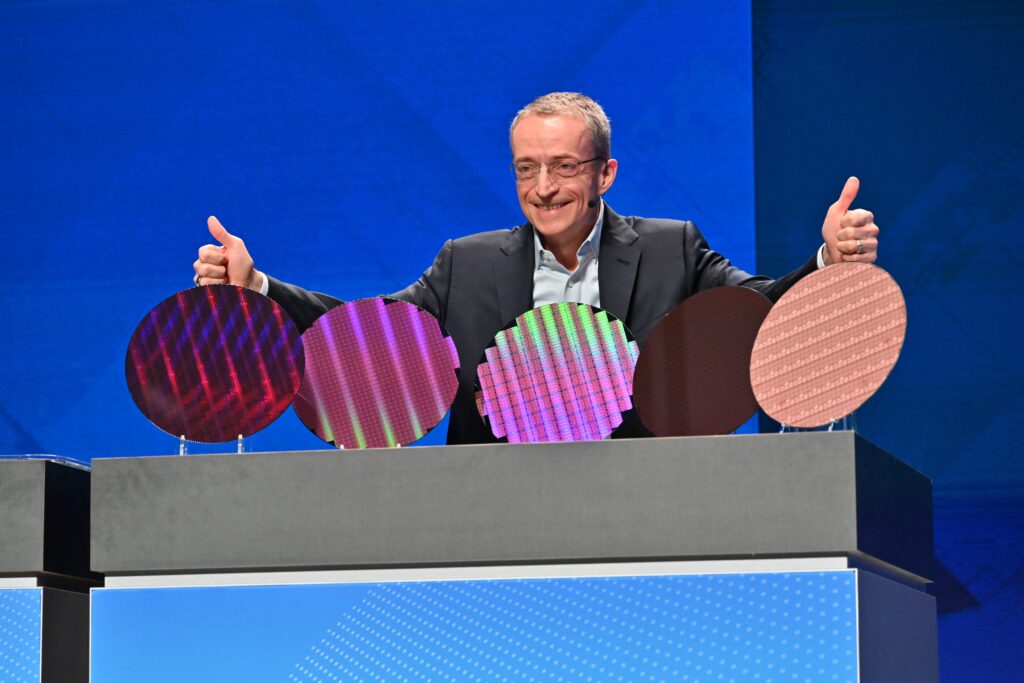With competition heating up in the foundry business – India this week approved three new semiconductor plants involving Tata Group and CG Power,, and is looking to achieve dominance in the industry – existing foundries have to up their game. Chief among them is Intel, which has been trying to recover from historical missteps that put it behind competitors such as TSMC and Samsung.
At its Intel Foundry Direct Connect event last week, it unveiled Intel Foundry, which will build not only its own chips, but products for anyone looking for fab services. It also announced a new organizational model.
“We’re not fixing one company, we’re establishing two vibrant new organizations,” said Intel chief executive officer Pat Gelsinger during his keynote. “Intel Foundry, to serve internal and external customers at scale, to manage supply chains, to assure capacity corridors, and Intel Products, our client, data centre and networking products. Two distinct and separate organizations.
“That begins today.”
AI, he said, will be incorporated everywhere, from data centre to cloud to network to edge to client, and it’s generating new excitement.
He noted, “When I showed up, it was like ‘This is boring. Here, let’s add a few more cores on the chip. Let’s make PCIe a little bit faster. Let’s increment the DDR. Boring.’ And then AI happened. End of boring. This is transforming everything about computing.”
And Intel plans to take advantage of this explosion of technology.
“Through our foundry, I want to manufacture every AI chip in the industry,” Gelsinger said. “Those internal that are being done by the cloud service providers, those merchant providers, the technology providers. We’re engaging in 100 per cent of the AI TAM [total addressable market]. And with that, we need a new model of what the foundry requirements are for that industry. And that’s, simply put, what we call the systems foundry for the AI era.”

Intel CEO Pat Gelsinger: “This is what we call a family photo mode. So, kids, come to papa, here we go – five nodes in four years.” Credit: Intel Corporation
He said that the company’s goal is to become the world’s number two foundry by 2030, and it will be the “world’s most sustainable foundry, committing to net-zero Scope 1 and Scope 2 GHG emissions by 2040, and net-zero upstream Scope 3 emissions by 2050.” It will also, he asserted, be the most resilient.
In 1990, 80 per cent of the semiconductors were built in US and Europe, Gelsinger noted. Today, 80 per cent are manufactured in a small concentrated area in Asia.
“We’ve seen this long, steady decline in terms of our supply chains for the world,” he said. “Nothing should be reliant on a single port to a single country, a single place in the world. We need resilience – resilient access to supply chains and capacity in the right regions at the right time. And thus the opportunity to drive systemic change, and where and how we drive the most important aspect of our future where the technology supply chains are. And as I’ve liked to say, the moonshot is 80/20 to 50/50 in a decade, rebalancing the supply chains of the world.”
Roadmap
Gelsinger also highlighted the company’s progress on its foundry process roadmap, announcing 14A, which he said is “venturing deeply into the Angstrom era,” as well as revealing extensions to existing nodes. And, he and Microsoft CEO Satya Nadella jointly announced that Microsoft has chosen Intel Foundry to build its own chip, based on the Intel 18A process.
Stuart Pann, senior vice president and general manager of Intel Foundry services, then took the stage to elaborate on the foundry’s activities.
“In this systems era, you can not only have to have open standards between devices, you have to have standards on the device.,” he pointed out, describing Intel as “a systems company turning into a foundry, not the other way around.”
But, he stressed, Intel can’t do it alone. Partners are key, and Intel has more than 30 ecosystem partners, including, he announced, Arm.
“This morning, we’re announcing a new partnership with Arm, an emerging business initiative. How do we take advantage of all the programs that Arm has to offer to bring design capability, design education out to all their customers. We’re doing this with Arm; we will make co-investments, will do joint programs, will provide shuttles at scale, Arm will provide IP at scale. And this is how we’re going to fuel this next wave of innovation.”
While Canada may not be in line for a fab (a semiconductor fabrication plant), at least not at the moment, Denis Gaudreault, Intel Canada country manager, said in an interview that this country is contributing in other ways.
Intel is now working with Markham-based ventureLAB, whose Hardware Catalyst Initiative supports the development of semiconductors, and has an R&D lab of its own on site. In fact, almost 90 per cent of Intel Canada’s employees in all locations work in engineering or development. And, he said, he’s continually looking for more ways that Canada can contribute.




![Intel-process-roadmap[1]](https://i.itbusiness.ca/wp-content/uploads/2024/03/Intel-process-roadmap1-696x468.jpg)
